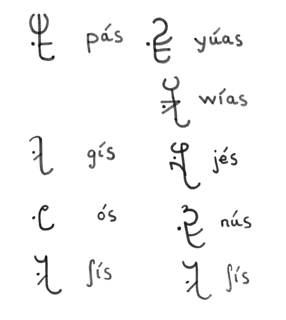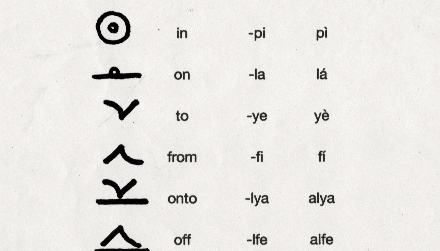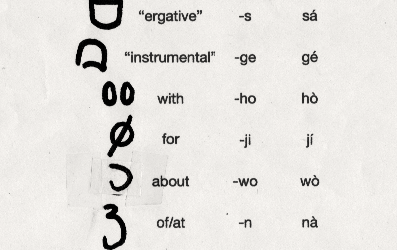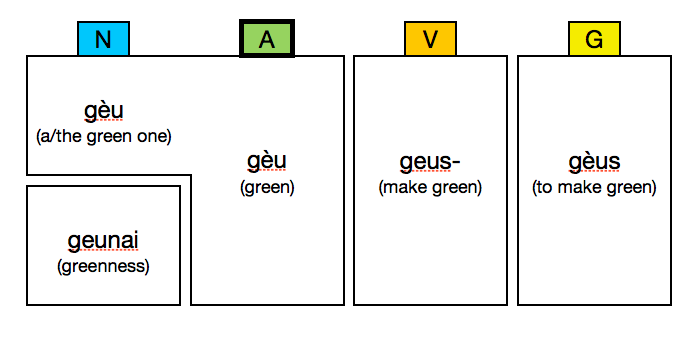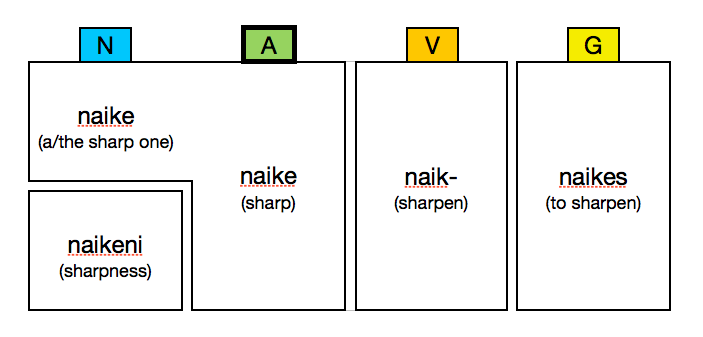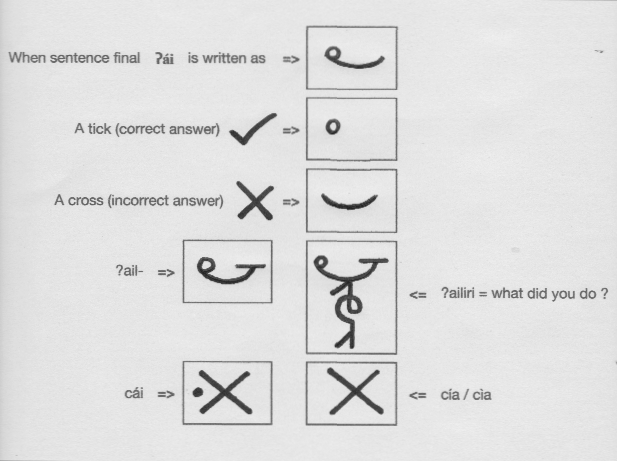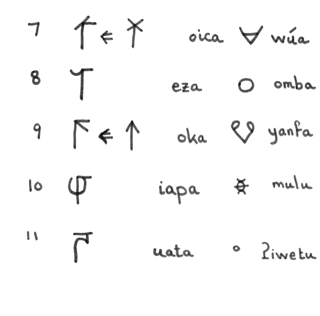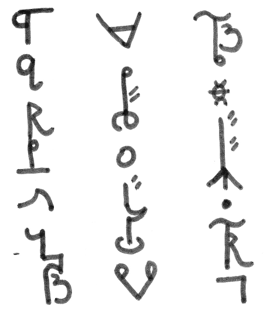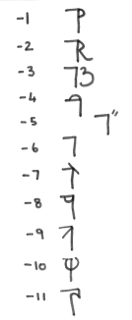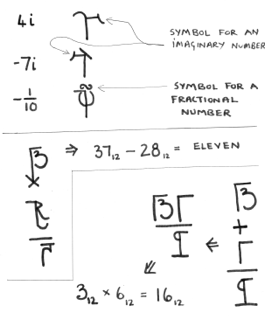Béu : Chapter 2
..... Pronouns
In this section we discuss pronouns and also introduce the S, A and O arguments.
béu is what is called an ergative language. About a quarter of the world languages are ergative or partly ergative. So let us explain what ergative means. Well in English we have 2 forms of the first person singular pronoun ... namely "I" and "me". Also we have 2 forms of the third person singular male pronoun ... namely "he" and "him". These two forms help determine who does what to whom. For example "I hit him" and "He hit me" have obviously different meanings (in English there is a fixed word order, which also helps. In béu the word order is free).
timpa = to hit ... timpa is a verb that takes two nouns (LINGUISTIC JARGON ... a transitive verb).
pás ò timpari = I hit him pà ós timpori = He hit me ... OK in this case the protagonist marking in the verb also helps to make things disambiguous. But this will not always help, for example when both protagonists are third person and of the same number.
So far so good. And we see that English and béu behave in the same way so far. But what happens when we take a verb that takes only one noun (LINGUISTIC JARGON ... a transitive verb). For example doika = "to walk". In English we have "he walked". However in béu we don't have *ós doikori but ò doikori (equivalent to saying "*him walked" in English). So this in a nutshell is what an ergative language is.
It is the convention to call the doer in a intransitive clause the S argument. For example òS fomporta = She has tripped
It is the convention to call the "doer" in a transitive clause the A argument and the "done to" the O argument For example ósA timpori jeneO = He hit Jane
The S was historically from the word "Subject" and the O historically from the word "Object", but it is best just to forget about that. In fact when I use the word "subject" I am talking about either the S argument or the A argument.
If you like you can say ;-
In English "him" is the "done to"(O argument) : "he" is the "doer"(S argument) and the "doer to"(A argument).
In béu ò is the "done to"(O argument) and the "doer"(S argument) : ós is the "doer to"(A argument).
Below the form of the béu pronouns is the given for when the pronoun is the A argument.
| I | pás | we (includes "you") | yúas |
| we (doesn't include "you") | wías | ||
| you | gís | you (plural) | jés |
| he, she | ós | they | ús |
| it | ʃís | they | ʃís |
In fact these pronouns are usually dropped when possible, so it might be better to translate the above as "I myself", "you yourself" etc. etc.
Below the form of the béu pronouns is the given for when the pronoun is the S or O argument. When they are used as S arguments it might be better to translate these pronouns as "I myself", "you yourself" etc. etc.
| me | pà | us | yùa |
| us | wìa | ||
| you | gì | you (plural) | jè |
| him, her | ò | them | ù |
| it | ʃì | them | ʃì |
The above table is for S and O arguments, it fact we have another pronoun but this one only occurs as an O argument. When a action is performed by somebody on themselves we use tí to represent the O argument.
Just as in English, we do not say "*I hit me", but "I hit myself" ... in béu we do not say *pás pà timpari, but pás tí timpari.
tí does not have to immediately* follow the ergative pronoun but it usually does.
LINGUISTIC JARGON ... "myself" is what is called a "reflexive pronoun". In English there are many reflexive pronouns (i.e. "myself", "yourself", "herself", etc. etc.) : in béu only one.
Pronouns can just be set down beside each other if they both make up the same argument in a clause. Unlike normal nouns which must have é ( "and" ) between them and any other component.
*It is a rule that tí must follow the A argument.
The possessive form of these pronouns
| my | pàn | our | yùan |
| our | wìan | ||
| your | gìn | your (plural) | jèn |
| his, her | òn | their | ùn |
| its | ʃìn | their | ʃìn |
And we also have tín which is used if the possessor is the same as the subject of the clause.
..... Building up a noun phrase (NP)
Now we talk about the béu noun phrase (called a cwidauza in béu). This can be described as ;-
Quantifier1 Head2 (Adjective3 x n) Genitive4 Determiner5 Relative-clause6
1) The Quantifier/Specifier is either a number or a word such as "all", "many", "a few" etc.
2) The head is usually a noun but can also be an adjective. When you come across an adjective as head of a noun phrase, its meaning is "the person/thing that is "adjective" ".
3) An adjective ... not much to say about this one, you can have as many as you like, the same as English.
4) A noun or pronoun that qualifies another noun (commonly called the Genitive in the Western linguistic tradition). Formed by suffixing -n to a normal noun makes it into a genitive.
5) Either dí "this", or dè "that".
6) This is a clause, beginning with ʔà that qualifies the head of the noun phrase. ʔà can be considered as a nominalizer, that is it is a particle that changes the following clause into a noun.
An interesting point is that in the absence of a "head", any of the other elements can act as the head.
..... The case system
These are what in LINGUISTIC JARGON are called "cases". The classical languages, Greek and Latin had 5 or 6 of these. Modern-day Finnish has about 15 (it depends on how you count them, 1 or 2 are slowly fading away). Present day English still has a relic of a once more extensive case system : most pronouns have two forms. For example ;- the third-person:singular:male pronoun is "he" if it represents "the doer", but "him" if it represents "the done to".
The 12 béu case markers are called pilana
The word pilana is built up from ;-
pila = to place, to position
pilana <= (pila + ana), in LINGUISTIC JARGON it is called a "present participle". It is an adjective which means "putting (something) in position".
As béu adjectives freely convert to nouns*, it also means "that which puts (something) in position" or "the positioner".
Actually only a few of them live up to this name ... nevertheless the whole set of 12 are called pilana in the béu linguistic tradition.
..
The pilana are suffixed to nouns and specify the roll these nouns play within a clause or within a NP.
The pilana are abbreviated to a single consonant in the béu writing system. That is, in the béu writing system, the final vowel of all pilana.
The pilana are partly an aid to quicker writing. However they also demarcate a set of 12 affixes and make quite a neat system.
You could call these 12 plus the unmarked noun a case system of 13 cases. Well you could if you wanted to (up to you).
Note that -lya and -lfe are represented by a special amalgamated symbols which do not occur elsewhere.
Notice that by a addition of pilana, you might expect to get the forms alye and alfi. As you can see this is not the case. Perhaps the amalgamated form has the final vowel changed under the pull of the initial vowel, a.
* You can tell if pilana is being an adjective or a noun by the environment that you find it in.
Now one quirk of béu (something that I haven't heard of happening in any natural language), is that the pilana is sometimes realised as an affix to the head of the NP, but sometimes as a preposition in front of the entire NP. This behaviour can be accounted for with thing with two rules.
1) The pilana attaches to the head and only to the head of the NP.
2) The NP is not allowed to be broken up by a pilana. The whole thing must be contiguous. So if a NP has elements after the head the case must be realised as a preposition and be placed in front of the entire noun phrase.
So if we have a NP with elements to the right of the head, then the pilana must become a preposition. The prepositional forms of the pilana are given on the above chart to the right. These free-standing particles are also written just using the symbols given on the above chart to the left. That is in writing they are shorn of their vowels as their affixed counter-parts are.
The letters m, b, k, g and d are free to be used as abbreviations. Perhaps m <= mò, two particles for joining clauses etc. etc.
*Another case when the pilana must be expressed as a prepositions is when the noun ends in a constant. This happens very, very rarely but it is possible. For example toilwan is an adjective meaning "bookish". And in béu as adjectives can also act as nouns in certain positions, toilwan would also be a noun meaning "the bookworm". Another example is ʔokos which means "vowel".
-pi or pì
meu (rà) "basket"pi
While the original meaning was about space, this pilana is very often found referring to time.
I read the book hourpi => I read the book in an hour
I gets dark pi ten minutes => It get dark in ten minutes
She qualified as a doctor pi five years
One can get from Glasgow to London daypi
I'm coming to Sweden pi next month
meu (rà) topla basketn = The cat is on top of the house
meu (rà) interior basketn = the cat is in the basket
-la or lá
mat (rà) floorla => the mat is on the floor ... notice "the mat"
twor mat floorla => there is a mat on the floor ... notice "a mat". Also the verb two is usually sentence initial, at least when introducing something new.
meu (rà) topla nambon => The cat is on top of the house
Notice that "topla nambon" is allowed, I should mention this somewhere.
twor ble pàn = I have (some) money
ble twor pàn = I have the money
tworka ble pàn = I don't have any money .... Note that it is also possible to say twor yà ble pàn, but the first method is definitely preferred.
ble tworka pàn = I don't have the money
bird (rà) top nambon = The bird is above the house
Notice that in the above example "top" is considered a specifier ... "top nambo" forms a tight compound.
The eight specifiers of location are above, below, right, left, this side (with respect to the speaker, of course), the far side
-ye or yè
kyis toili oye = give the book to her
This is the pilana used for marking the receiver of a gift, or the receiver of some knowledge.
However the basic usage of the word is directional.
*namboye => nambye = "to the house"
distanceye nambon = "as far as the house"
"limit"ye nambon = "up to the house" ... this usage is not for approaching humans however ... for that you must use "face".i.e. "face"ye báun = right up to the man
yèu = to arrive ... yài a SVC meaning "to start" ... fái a SVC meaning "to stop" ???
-fi or fí
nambofi = "from the house"
fí "direction" nà nambo = "away from the house" i.e.you don't know if this is his origin but he is coming from the direction that the house is in.
fí "limit/border" nà nambo = all the way from the house
fí "top" nà nambo = from the top of the house ... and so on for "bottom", "front", etc. etc.
he changed frog.fi ye prince handsome = he changed from a frog to a handsome prince
fía = to leave, to depart ... fái a SVC meaning "to finish" .... then bai cound mean continue and -ana would be the present tense ???
-lya or alya
Sometimes called the "Allative case" but we don't have to worry about that rubbish here. Can be said to translate to English as "onto".
xxx yyy zzz = put the cushions on the sofa
-lfe or alfe
The ablative
-s or sá
that Stefen turned up drunk at the interview sank his chance of getting that job
sá tá ........
-ʔe or ʔé
The instrumental is used for nouns that represent the instrument ("with"), the means ("by") or the agent ("by").
John writes with a pen
banu = to learn
banuʔe = by learning
book was written paʔe = The book was written by me
andaʔe = manually
I work as a translator ??? ... I work sàu translator ??
ʔé ta ...
-ho or hò
The commitive
"in the company of", often used with the personal pronouns ;-
| with me | paho | with us | yuaho |
| with us | wiaho | ||
| with you | giho | with you (plural) | jeho |
| with him, with her | oho | with them | uho |
| with it | ʃiho | with them | ʃiho |
tùa = to use, to wear ... tàu a SVC meaning ??
-ji or jí
The benefactive. Sometimes used with gomia
banu = to learn, banuji = in order to learn
-wo or wó
Used for marking the "theme" as in such sentences as the one below.
gala caturi jonowo => The women were talking about John
jonowo ... = as for John ....
-n or nà
The locative or the possessive. Basically if the noun is human, it is the possessive : if the noun is non-human, it is locative.
nambo jonon (rà) hauʔe = John's house is beautiful
jono (rà) nambon = John is at home
Some example;-
fanfa = horse
sonda = son
blico = king
fanfa sondan = the horse of the son
sonda blicon = the son of the king
However the suffixed form can only be used if the genitive is a single word. Otherwise the particle na must be placed in front of the words that qualify. For example ;-
We can't say *fanfa sondan blicon however. The -n on sonda is splitting the NP sonda blico.
So we must say fanfa nà sonda blicon
Some more examples ...
fanfa nà sonda jini blicon = "the horse of the king's clever son
fanfa nà sonda nà blico somua = "the horse of the fat king's son"
..... Adjectives and how they pervade other parts of speech
Earlier on in this chapter we discussed parts of speech. In béu, sometimes, an unmodified word can belong to 2 or 3 different parts of speech at once.
Also earlier on I introduced the gomua (G) or the infinitive, as a part of speech. This is the "base form" of the verb and it resembles a noun in many respects. It is being treated as a seperate part of speech ... just for convenience really. I do not want to get into an argument about linguistic theories etc. etc. This is just to make things easy to discuss.
Let us start of with a single-syllable adjective. Let us see what forms a single-syllable adjective can take and what "parts of speech" these forms can belong to. Consider the word gèu "green" ;-
Along the top of the above chart you can see N, A, V and G (noun, adjective, verb and gomua).
The form under these 4 headings, shows the form gèu takes when it is one of these 4 parts of speech. gèu is fundamentally an adjective (that is what the thicker border around the "A" means).
You can see that we have two nouns forms in the above chart. One has its original form, I call this one "the substansive noun" (meaning "the green one"). The other changes its form by taking the affix -n. I call this one "the qualitative noun" (meaning "greenness").
We can see that we can derive a verb from gèu. By affixing -s we get an transitive verb meaning "to make green". You can see that the V-forms and the G-forms are the same.
Actually the V-form is not gèus. The V-form is actually a myriad of forms. But they are all built up from the gèus foundations. As an example let us build up one of the myriad of forms that the V-form can take. First we add a vowel, either a, i, o, u, e, au or ai, that represents the subject ... then we add, either r, n or s (depending on if we want the indicative mood, the subjunctive nood or the imperative) ... then we add a vowel (or consonant + vowel) as a tense/aspect marker, either ??? ... then we possibly add an evidential marker, either n, s or a. So we could get geus + i + r + i +a => geuʃiria = "you became green, I saw it" ... one of the many forms considered as a V-form.
OK. We have seen how a single-syllable adjective works. Now for a 2-syllable adjective. Consider the word naike "sharp" ;-
We can see that in this case it is possible to have 3 parts of speech from only one form. However in this case the "finite" verb (V) is built up directly from naike and not from the G-form. So, for example, we have naikiria = "you sharpened (it), I saw you do it". Rather than *naikeʃiria.
..... 64 Adjectives
| good | bòi* | bad | kéu |
| long | làu | short | lái |
| high, tall | hài | low, short | ʔáu |
| right, positive | lugu | left, negative | liʒi |
| white | ái | black | àu |
| young | sài | old (of a living thing) | gáu |
| clever, smart | jini | stupid, thick | tumu |
| near | nìa | far | múa |
| new | yaipe | old, former, previous | waufo |
| big | jutu | small | tiji |
| hot | fema | cold | pona |
| open | nava | close | mapa |
| simple, easy | baga | complex, difficult, hard | kaza |
| sharp | naike | blunt | maubo |
| wet | nuco | dry | mide |
| empty | fene | full | pomo |
| fast | saco | slow | gade |
| strong | yubu | weak | wiki |
| heavy | wobua | light | yekia |
| beautiful | hauʔe | ugly | ʔaiho |
| contiguous, touching | yotia | apart, separate | wejua |
| fat | somua | thin, skinny | genia |
| bright | selia | dull, dim | golua |
| thin | pilia | thick | fulua |
| east, dawn, sunrise | cúa | west, dusk, sundown | dìa |
| tight | taitu | slack, loose | jauji |
| neat | ilia | untidy | ulua |
| soft | fuje | hard | pito |
| wide/broad | juga | narrow | tisa |
| rough | gaʔu | smooth | sahi |
| deep | gubu | shallow | siki |
| right | sèu | wrong | gói |
In the above list, it can be seen that each pair of adjectives have pretty much the exact opposite meaning. However in béu there is ALSO a relationship between the sounds that make up these words.
In fact every element of a word is a mirror image (about the L-A axis in the chart below) of the corresponding element in the word with the opposite meaning.
| ʔ | ||||
| m | ||||
| y | ||||
| j | au | |||
| f | o | |||
| b | oi | |||
| g | i | |||
| d | ia | high tone | ||
| l | =========================== | a | ============================ | neutral |
| c | ua | low tone | ||
| s/ʃ | u | |||
| k | eu | |||
| p | e | |||
| t | ai | |||
| w | ||||
| n | ||||
| h |
* Note that the adverb version of this word is slightly irregular. Instead of boiwe it is bowe. People often shout this when impressed with some athletic feat or sentiment voiced ... bowe bowe => well done => bravo bravo
Also instead of keuwe we have kewe. People often shout kewe kewe kewe if they are unimpressed with some athletic feat or disagree with a sentiment expressed. Equivalent to "Booo boo".
..... The parts of speech of béu
"Parts of speech" is linguistic jargon, which is referring to the different "classes" of words a language might have. For example "nouns", "verbs", etc. etc.
In fact nouns (N), verbs (V) and adjectives (A) are the big three, and after some debate over the last 30 years, it has been agreed that every language has these three word classes.
In béu a noun is called cwidau (cwì meaning a physical object), a verb is called jaudau (jàu meaning "to move"), and an adjective is called saidau (sái meaning "a colour").
There are other classes of words in béu as there are in other languages. béu has adverbs (wedau) but these don't really come into their own, being more a form an adjective takes in certain situations. Also a lot of words that are called adverbs in English are called particles (feŋgia) (F) in béu. Particles are a type of hold-all category for a word that doesn't fit into any of the other classes. Under the term "particle" many subclasses can be defined, and in fact some subclasses have a class membership of one. If you come across a word that can not easily be equated with any of the major word classes ... well then you probably have a feŋgi.
It is necessary to talk about another part of speech which i will refer to by the béu term gomia* (G). It is a form of the verb which is called the "infinitive" in the Western linguistic tradition.
* goma means "tail" and gomia means "tail-less". The reason for this is that a verb in a sentence functioning as verbs commonly do, has person, number, tense, aspect and evidentiality expressed on the verb as series of suffixes, hence the "tail". These items are not expressed on the gomia.
In contradistinction to gomia we have gomua (jaudau gomua to give the concept its full title) which is a verb in a sentence functioning as verbs typically do.
For example solbarin (I drank, so they say) is a gomua.
solbarin is built up from the gomia "solbe" ... first you delete the final vowel => then you add "a" meaning first person singular subject => then you add "r" meaning that the mood is indicative (as opposed to imperative or subjunctive) => then you add "i" meaning simple past tense => and finally you add "n" which is an evidential, meaning that the utterance is based on what other people have said.
solbarin is gomua pomo or "a full tail verb".
The three evidential markers are all optional, so they can quite easily be dropped. solbari (I drank) is what is called gomua yàu or "a long tail verb".
solbis (you lot drink) and solbon (let him drink) are gomua wái or "a short tail verbs" ... the first is an example of the imperative and the second is an example of the subjunctive (more linguistic jargon ... sorry).
solbai is called an part verb ???
..... Some linguistic terms in béu
By the way, while we are at it (defining linguistic terms)
nandau = word
semo = a clause ... from the verb "to say" sema
semoza = a sentence
jaudauza = a verb phrase or verb complex (commonly called a "predicate" by linguists). This is the verb together with the five modals.
feŋgi = a particle ... given above
plofa = a participle (P) ... there are 3 participles in béu
ʔasemo = a relative clause
kalope = a complement clause. There are three types of these ... kalope jù, kalope tà and kalope tavoi
A kalope jù is a gomiaza if it is more than one word long, if only one word long it is simply a gomia
A gomiaza can comprise of subject ... gomia ... object ... adverb ... other peripheral terms
The term gomuaza is not used. You would use the word semo meaning clause.
taifi (that which is to be tied ??? check participles) = copular subject
taifo = copular complement
taifau = to tie
taifana = a copula
..... How to bring a word into focus
Actually there is a way to focused elements in a statement which mirrors the way to focus elements in a question. We use cà for this.
Statement 1) báus glaye timpi alhai = the man gave flowers to the woman
Focused statement 2) báus glaye cà timpi alhai = It is the woman to whom the man gave the flowers.
Any argument or in fact the verb itself can be focused in this way.
..... Questions
béu has a "toolbox" that allows us to ask questions. The tools in that box are ʔái, nái, gwaili and cái ... the 4 words used for asking questions.
..... How to ask a yes/no question
To turn a normal statement into a polar question (i.e. a question that requires a YES/NO answer), we stick the particle ʔái on the end of the sentence.
ʔái is neutral as to the response you are expecting. If you are expecting a positive reply, you would use the particle ʔaiwa instead.
To answer a positive question, YES or NO ( ʔaiwa àu aiya ) is sufficient.
To answer a negative question positively, YES ( ʔaiwa ) is enough.
To answer a negative question negatively, you must give an entire clause.
For example ;-
Question 1) glà (rà) hauʔe ʔái = Is the woman beautiful ? .......... If she is beautiful, answer ʔaiwa, if she isn't answer aiya.
Question 2) glà ká hauʔe ʔái = Isn't the woman beautiful ? ........ If she isn't beautiful, answer ʔaiwa, if she is answer ò rà hauʔe. (notice that the copula must be used in this case)
Also it is possible to focus on a particular element when asking a YES/NO question in béu. This is done by putting the particle cái after the element that you want to focus on. For example ...
Statement 1) báus glaye timpi alhai = the man gave flowers to the woman
Straight question 2) báus glaye timpi alha ʔái = did the man gave flowers to the woman ?
Focused question 3) báus glaye cái timpi alha = Is it the woman that the man gave flowers to ?
Focused question 4) báus cái glaye timpi alha = Is it the man that gave flowers to the woman ?
Focused question 5) báus glaye timpi alha cái = Is it flowers that the man gave to the woman ?
Focused question 6) báus glaye timpi cái alha = the man GAVE flowers to the woman ?
..... How to ask a content question
béu is unusual in that it has only two content question words ... nái and gwaili.
English is more typical of languages in general and has 7 content question words ... "which", "what", "who", "where", "when", "how" and "why".
nái means "which" and most English content question words are equivalent to a generic noun followed by nái.
| what | dài nái |
| who | bù nái |
| where | hà nái |
| when | kyù nái |
| what type of .... | myàn nái |
| how | wè nái |
| how much | bà nái |
| how many | nò nái |
The one exception is gwaili which means "why". By itself gwài and lí can be translated as reason. However "reason" is always connected to some action ( occasionally it is connected to some state, but prototypically it is connected to a certain action ). gwài means "reason" but more specifically "reason behind" or "cause". lí also means "reason" but more specifically "reason towards", "objective", "purpose", "goal" or "aim". Now when you question a certain action, you don't know whether that action will be explained as leading on from something that has happened before, or as necessary for some other action/state that is desired in the future. Hence *gwài nái or lí nái would not be appropriate as question words.
In English as in about 1/3 of the languages of the world it is necessary to front the content question word. This is not necessary in béu.
The pilana are added to the content question words as they would be to a normal noun phrase.
In fact there is one contraction that takes place. It is sá bù nái => sù nái.
So you could say that sù nái = "who", and bù nái = "whom"
Here are some examples of content questions ...
Statement 1) báus glaye kyori alha = the man gave flowers to the woman
Question 2) sù nái glaye kyori alha = who gave flowers to the woman
Question 3) báus ye bù nái kyori alha = to whom did the man gave flowers
Question 4) báus glaye kyori dài nái = what did the man give to the woman
TO THINK ABOUT
Notice that in 5, nái and the word that it is conjoined with, can not be seperated by the pilana ye.
"which one" would be translated as ʃì nái if we are referring to a non-A argument and non-human.
"which ones" would be translated as nò ʃì nái if we are referring to a non-A argument and non-human.
"which one" would be translated as ò nái if we are referring to a non-A argument but human.
"which ones" would be translated as ù nái if we are referring to a non-A argument but human.
Of course to refer to an A argument, we simple add -s to the pronoun.
..... How to ask what is being done
béu is unusual in that it has a word that is a question verb.
ʔail- meaning "to do what". For example ...
ʔailiri = "what will you do"
ʔailora jonos jene = "what is John doing to Jane"
It doesn't have to be fronted but it usually is.
Some of the words mentioned above are very common. Because of this, they have a shorthand way of being written.
..... The relativizers
The relativizer in béu is ʔà. This takes all the pilana the same as a normal noun.
When the relative clause is giving extra information, the relativizer in is ʔài and a slight pause comes before it.
There is another relativized in béu that refers back to a whole proposition. In English "which" is sometimes given this function. For example ...
1) ... John had completely forgotten his wedding anniversary which really annoyed his wife.
béu uses nài in a similar way to how which is used in the above example. Also the same shorthand form is used for nài and nái. However no misunderstanding is possible since nài always has a pause before it (how do I do a comma ?) and nái always is immediately after a noun.
..... Simple arithmetic
noiga = arithmetic
Above right you can see the numbers 1 -> 11 displayed. Notice that the forms of 1, 3, 6, 7 and 9 have been modified slightly before the "number bar" has been added.
In the bottom right you can see 7 interesting symbols. These are used to extend the range of the béu number system (remember the basic system only covers 1-> 1727). Their meanings are given in the table below.
| elephant | huŋgu |
| rhino | nàin |
| water buffalo | wúa |
| circle | omba |
| hare | yanfa |
| beetle | mulu |
| bacterium, bug | ʔiwetu |
To give you an idea of how they are used, I have given you a very big number below.
Which is => 1,206,8E3,051.58T,630,559,62 ... E represents eleven and T represents ten ... remember the number is in base 12.
O.K. this number has a ridiculous dynamic range. But this is for demonstration purposes only: if you can handle this number you can handle any number.
This monster would be pronounced aja huŋgu ufaila nàin ezaitauba wúa idauja omba idaizaupa yanfa elaibau mulu idaidauka ʔiwetu elaifau dó
Now the 7 "placeholders" are not really thought of as real numbers, they are markers only. Used in the same way that we would say "point"/"decimal" when reeling off a number.
When first introduced to this system, many people think that the béu culture must be untenable, however strangely enough the béu culture has lasted many thousands of year, despite the obvious confusion that must arise when they attempt to count elephants.
One further point of note ...
If you wanted to express a number represented by digits 2->4 from the LHS of the monster, you would say aufaidaula nàin .... the same way as we have in the Western European tradition. However if you wanted to express a number represented digits 6 ->8 from the RHS of the monster, you would say yanfa elaibau .... not the way we do it. This is like saying "milli 630" instead of "630 micro".
To make a number negative the "number bar" is placed on the left. See below ;-
Also a number can be made imaginary by adding a further stroke that touches the "number bar". See below ;-
As you can see above, there is no special sign for the "addition operation". The numbers are simply written one beneath the other. Similarly with subtraction but one number would be negative this time.
There is a special sign to indicate multiplication (+), and there is an equals sign (-).
Division is the same as multiplication except that one of the numbers is in "fractional form".
There is an alternative multiplication/division notation : instead of using the + sign, the two quantities can instead be written side by side (see the example above).
-6 is pronounced ela liʒi ... liʒi means left or "negative
By the way lugu means right (as in right-hand-side) or positive.
4i is pronounced uga haspia ... and what does haspia mean, well it is the name of the little squiggle that touches the number bar, for one thing.
-4i is pronounced uga haspia liʒi
-1/10 is pronounced diapa liʒi
i/4 is pronounced duga haspia
And so ends chapter 2 ...
..... Index
- Introduction to Béu
- Béu : Chapter 1 : The Sounds
- Béu : Chapter 2 : The Noun
- Béu : Chapter 3 : The Verb
- Béu : Chapter 4 : Adjective
- Béu : Chapter 5 : Questions
- Béu : Chapter 6 : Derivations
- Béu : Chapter 7 : Way of Life 1
- Béu : Chapter 8 : Way of life 2
- Béu : Chapter 9 : Word Building
- Béu : Chapter 10 : Gerund Phrase
- Béu : Discarded Stuff
- A statistical explanation for the counter-factual/past-tense conflation in conditional sentences
